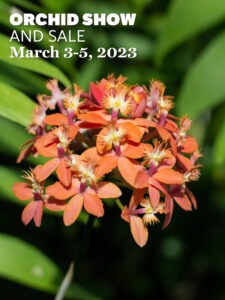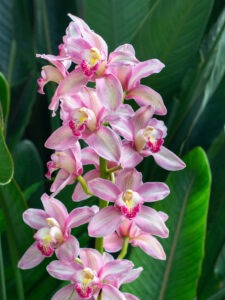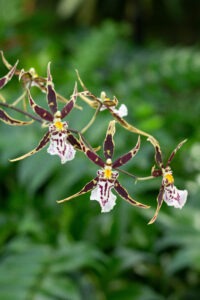Orchid Show & Sale 2023

Epidendrum Peach Valley ‘Dream Song’
The Virginia Orchid Society’s Show & Sale Friday, March 3-Sunday, March 4, 2023, features hundreds of blooming orchids and vendors from across the globe. Lectures for the absolute beginner to orchid aficionado will be held here at Lewis Ginter Botanical Garden.
With orchids making up one of the largest families of flowering plants in the world, they are known for their range of flower colors, textures and forms. Given this diversity, especially in the growing range, the care of these plants may be tricky to nail down for any grower, but this seems to add to their charm.
When an orchid is in bloom the visual appeal can bring a sense of serene tropical energy to any space or garden. With the addition of a beautiful fragrance that can last for months, it is clear to see why so many growers love to grow and create new orchid varieties each year.
We were able to chat with Stanley Baker, an experienced orchid grower and hybridizer (also Vendor Coordinator for the show), to talk all about orchids in anticipation of this event. With the success of the Show and Sale last year, we are hoping for the same incredible turnout and hope these questions will pique your interest in this large family of flowering plants.
Interview Q&A with Stanley Baker:
Q: What are you excited to see at the Virginia Orchid Society Show and Sale this year?
It wouldn’t be one specific thing. As I’m the vendor coordinator, we were able to engage eight vendors, orchid-related jewelry, and a potter who makes special orchid pots. There will be a bunch of vendors in the auditorium this year, with all different kinds of things. If last year was any indication we were close to selling out. We’re hoping for a huge influx of people and interest this year too.
Q: When judging an orchid for a show like this one are there certain characteristics you’re looking for?
Each judge has a card they take around. On the national level it’s a very regimented kind of process. They will give points for various things like flower shapes, quantity and the condition of the plant itself. There are even awards for only when you’re looking at the flowers and other times there are awards for the condition of the entire plant like a cultural award.
If you’re judging a species then you look at the characteristics that the species brings to the table. For instance laelia – the curly petals are one of their characteristics. With cattleyas, their ideal flowers are as flat as possible, with overlapping petals.
Q: How long does it take to get an orchid to flower?
The general rule of thumb is that from pollination to first flowering is about seven years. Orchids grow slowly and cattleyas in particular. The seed pod can be on the plant for up to a year as it’s growing and maturing. The longer it stays on the plant the more viable it is.
Then there is a flasking process. Orchid seeds are very fine like dust. They’re dispersed by the wind in nature and they are put into a flask with an agar solution – kind of like when scientists grow a culture of bacteria. They have to be re-flasked a couple of times as they begin to grow. It has to be a sterile process.
Q: Is one orchid variety more prestigious than another?
Cattleyas have always been prestigious, that started way back when explorers first discovered the South American cattleyas and they made a huge impact in England and Europe. The wealthy would fund explorers’ trips to try and find these cattleyas.
Q: What goes into creating a new hybrid?
Professional hybridizers do plan this process. They try to choose parents with certain characteristics like with the color, so it is not an easy process by any means. They’re trying to improve nature. Just like with any plant there is a symbiotic relationship with a pollinator, and orchid pollen is very different from the dust-like pollen that you may see on a lily that can stain your clothes. Orchid pollen is much larger, they’re like little granules.
Q: Do you recommend watering Orchids with ice cubes?
No. Sometimes you will see instructions to use an ice cube to water. Don’t do that. There is never water anywhere near that cold that comes to an orchid in nature. It is cooler, but not like an ice cube. I think growers started suggesting an ice cube because it is a small measure of water. The number one killer of orchids is over-watering in the home.
The vast majority of orchids that you will see are in these containers that don’t have a drain hole. There usually is a liner inside the container and you can take that out and that’s what you want to water. You can soak it and then let it drain for a while then put it back. That will help prevent overwatering.
Q: Tips for success for growing indoors?
Don’t over water, that’s the number one thing.
Four things to remember to try to get them to rebloom:
- They have to see a difference between night and day, you can’t have the lights on all the time because in nature it’s a day and night cycle.
- They love to go outside because of the temperature differential between day and night. They are used to that in nature and that will stimulate them to grow and flower.
- They have to have adequate light, some people grow them too dark. I always say that if it’s not flowering for you then acclimate it to a little more light. You can’t do it quickly or the leaves will burn, partially on a phalaenopsis.
Q: Which orchids have the best fragrance?
The genus Encyclia can smell wonderful. There is one called Encyclia phoenicea. I have a hybrid with that Encyclia phoenicea and the spike on it is seven feet tall – just the spike. It’s in spike now. It has an incredibly delicious fragrance.
The group of orchids in the genus Catasetum has a kind of spicy fragrance. If you were to smell it, you can smell the difference. Also many of the cattleyas have a really nice fragrance, too.
Show & Sale Event page: bit.ly/OrchidShowandSale23

